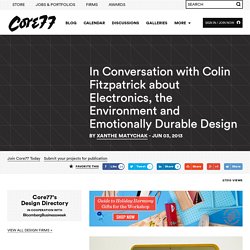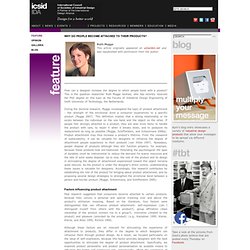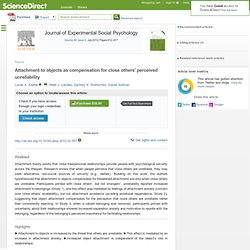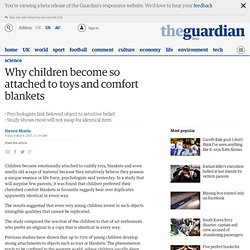

Towards happiness: Possibility-driven design by Marc Hassenzahl. Positive Design: An Introduction to Design for Subjective Well-Being. Positive Design: An Introduction to Design for Subjective Well-Being Pieter M.

A. Desmet* and Anna E. Pohlmeyer Faculty of Industrial Design Engineering, Delft University of Technology, Delft, The Netherlands This paper addresses the question of how design can contribute to the happiness of individuals–to their subjective well-being. Keywords – Design for Subjective Well-Being, Happiness, Flourishing, Design Framework, Positive Design. Relevance to Design Practice – This paper introduces a general framework for designing for subjective well-being and discusses research challenges in the domain of “Positive Design.”
Citation: Desmet, P. Received Sep. 26, 2013; Accepted Oct. 10, 2013; Published Nov. 30, 2013. Copyright: © 2013 Desmet & Pohlmeyer. *Corresponding Author: p.m.a.desmet@tudelft.nl. In Conversation with Colin Fitzpatrick about Electronics, the Environment and Emotionally Durable Design. Image courtesy of IAMECO I recently met Colin Fitzpatrick at the International Symposium on Sustainable Systems and Technologies, where he spoke about the IAMECO (pictured above), a product service system that he and his research group worked on with an Irish SME, MicroPro Computers.

Colin is at MIT this summer, researching "Conflict Minerals," which are the raw materials used in electronics that come from the war torn Democratic Republic of the Congo. Needless to say, he's doing great work in the area of sustainable electronics. And lucky for us, he had some time to chat about his work and where he thinks all of this is going in the near future. Xanthe Matychak: So, tell us about yourself. Colin Fitzpatrick: I'm a lecturer in electronic computer engineering at the University of Limerick in Ireland and I've been working in the "Electronics and the Environment" area since about 2004. Right. WHY DO PEOPLE BECOME ATTACHED TO THEIR PRODUCTS? How can a designer increase the degree to which people bond with a product?

This is the question researcher Ruth Mugge tackled, who has recently received her PhD degree on this topic at the Faculty of Industrial Design Engineering of Delft University of Technology, the Netherlands. During the doctoral research, Mugge investigated the topic of product attachment - the strength of the emotional bond a consumer experiences to a specific product (Mugge 2007). This definition implies that a strong relationship or tie exists between the individual on the one hand and the object on the other. If people feel strongly attached to a product, they are also more likely to handle the product with care, to repair it when it breaks down, and to postpone its replacement as long as possible (Mugge, Schifferstein, and Schoormans 2006a). Product attachment may thus increase a product's lifetime. Factors influencing product attachment. Design & Emotion - a website by Marco van Hout.
Donald A. Norman is a professor emeritus of cognitive science at University of California, San Diego and a Professor of Computer Science at Northwestern University, but nowadays works mostly with cognitive sc ience in the domain of usability engineering. He also teaches at Stanford University and is a member of the editorial board of Encyclopædia Britannica.
Norman’s earlier books deal mostly with usability or with cognitive psychology, but Things That Make Us Smart also makes a few remarks of critical nature regarding our society, in particular Norman dislikes the content-less nature of television and bad museum exhibits. Lately he has tended to focus on the positive. He loves products which are enjoyable to use, a feature which he attributes to putting together emotion and design, or heart and mind. He is a promoter of the concept of information appliances, which he has covered in his book The Invisible Computer. Journal of Experimental Social Psychology - Attachment to objects as compensation for close others' perceived unreliability. Abstract Attachment theory posits that close interpersonal relationships provide people with psychological security across the lifespan.

Research shows that when people perceive that close others are unreliable, they may seek alternative, non-social sources of security (e.g., deities). Emotional attachment to objects - an AS thing? I remember a story about a woman who married the Eiffel Tower, and another who married part of the Berlin Wall or something.

One of them popped up an a forum and mentioned having Asperger's. There was a word for that, but I can't remember what it is. Ok, found that article I saw: When I was a kid I did feel attached to objects a lot. As I got older I tried to consciously tune it out because it would get to be too much and would get in they way of rationally functioning -- like if I needed a box of sugar, and there's only two left on the store shelf, and if I buy one, then the other will be all alone... poor box of sugar... and then, "WTH am I thinking? I don't know if it's a common thing, but I remember reading Donna Williams mentioning in one of her books attachments to objects, or projecting life onto non-living things. Why children become so attached to toys and comfort blankets. Children become emotionally attached to cuddly toys, blankets and even smelly old scraps of material because they intuitively believe they possess a unique essence or life force, psychologists said yesterday.

In a study that will surprise few parents, it was found that children preferred their cherished comfort blankets or favourite raggedy bear over duplicates apparently identical in every way. The results suggested that even very young children invest in such objects intangible qualities that cannot be replicated. The study compared the reaction of the children to that of art enthusiasts who prefer an original to a copy that is identical in every way. Previous studies have shown that up to 70% of young children develop strong attachments to objects such as toys or blankets. The phenomenon tends to be confined to the western world, where children usually sleep apart from their parents at an early age.
A few moments later a buzz came from the second box. Emotional attachment: Developing lasting relationships with our belongings. These days, a product’s physical longevity will not prevent it from being thrown away if the owner no longer wants it.

Www.ijdesign.org/ojs/index.php/IJDesign/article/viewFile/325/205.